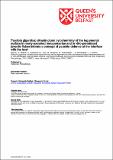Fasciola gigantica: ultrastructural cytochemistry of the tegumental surface in newly-excysted metacercariae and in vitro-penetrated juvenile flukes informs a concept of parasite defence at the interface with the host
Abstract/
Cytochemical staining techniques were carried out en bloc with in vitro excysted and gut-penetrated Fasciola gigantica larvae in order to visualise the glycocalyx of the tegument, a structure which comprises the parasite component of the host-parasite 22 interface, yet is incompletely preserved by conventional fixation and preparation techniques for electron microscopy. Positive reactivity with ruthenium red and periodic acid-thiocarbohydrazine-osmium (PATCO) techniques revealed that the glycocalyx is polyanionic and carbohydrate-rich throughout its depth. It comprises a trilaminate arrangement, with a thin dense zone and fibrillar layer closely apposed to the outer aspect of the apical plasma membrane, invested by an irregular thick mucopolysaccharide capsule. The latter, not recorded in adult flukes, may represent a specific adaptation to facilitate invasion in the face of host immunity, and may also 30 protect the parasite surface from the action of host- and parasite-derived proteases. Early in the invasion of a naïve host, the glycocalyx may be partly responsible for triggering the responses of innate immunity, while later in infection, or when an anamnestic response is initiated in an immunocompetent host, the antibodies and activated lymphocytes of specific acquired immunity are invoked to interact with the parasite surface. The cytochemical properties of the glycocalyx, together with its 36 potential for dynamic turnover due to exocytosis of the T0 tegumental secretory bodies, are likely to aid neutralisation of potentially damaging immune effectors and ensure their removal from the vicinity of the parasite by sloughing in complex with glycocalyx components.
Collections
- Department of Zoology [161]

